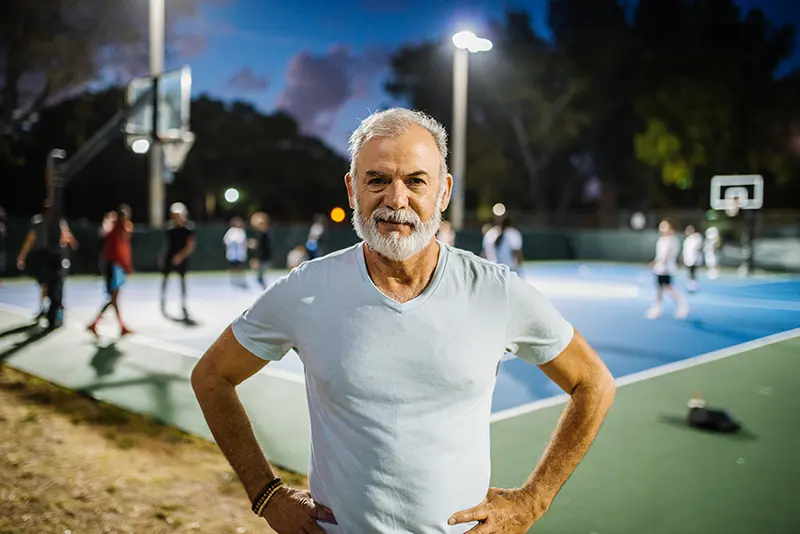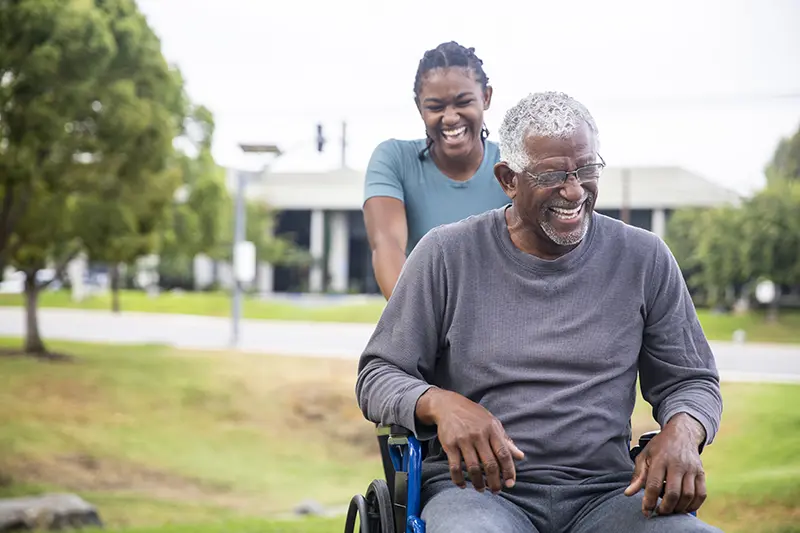Brain and Body Health

Staying as healthy as possible means more quality time with family.
Male, 60–691
- 44% rate their health as excellent or very good: 39% of 50s, 44% of 60s, 49% of 70s, 49% of 80-plus.
- 50% are extremely or very concerned about maintaining brain health: 52% of 50s, 52% of 60s, 45% of 70s, 48% of 80-plus.
- 45% are extremely or very concerned about maintaining physical health: 45% of 50s, 49% of 60s, 40% of 70s, 42% of 80-plus.
- 77% have at least one serious or chronic condition, 66% of 50s, 75% of 60s, 83% of 70s, 81% of 80-plus.
Source: Vicki Levy and Patty David, Second Half of Life Study, in Collaboration with National Geographic Partners and Heart+Mind Strategies, AARP Research, June 2022.
The state of one’s body and brain health is on the minds of adults age 50-plus, whether they are focused on maintaining their health, concerned about future health or coping with a chronic illness or physical changes. Adults 50-plus view health of body and mind as a facilitator, enabling them to do what makes them happy, and be with and support the ones they love. For some, improving their health or overcoming health challenges are ideals to look forward to as they get older. Topics related to this include:
- Importance and perceptions of body and brain health
- Maintaining health
- Health concerns
- Health conditions
- Disabilities

PHYSICAL HEALTH IS ON OLDER ADULTS’ MINDS, BUT REPRESENTS POTENTIAL, NOT JUST PROBLEMS:
Well, I’d say the second quarter, the last quarter of my life I think. I’m already well into the second half. They say that these are the golden years, and to me it’s the golden years as long as you’re healthy. So one thing that I try to do is remain healthy. I exercise, I eat well, but then that allows me to do things that I enjoy doing, I enjoy playing basketball still, and at 68 years old I’m still playing basketball with 30-year-old kids. I’m not as good as I used to be, but I can still play, which is amazing. I like to travel with my wife. We travel around the world a couple times a year, and you need to be healthy and physically in shape to do that.
Male, 65–74
Source: Vicki Levy and Patty David, “AARP's Second Half of Life Study, in Collaboration with National Geographic Partners and Heart+Mind Strategies,” AARP Research, (June 2022).
Most adults 50-plus agree that “being in good health” is part of “a good life.”2 In fact, being in good health is the most important element.
Percent who consider each factor as part of “a good life”
Importance and Perceptions of Body and Brain Health
Brain health and physical health are a significant concern for about half of adults 50-plus, with concern more likely felt among those with high self-ratings of health.
Brain health tops a list of concerns when thinking about aging, with 50% of adults 50-plus extremely or very concerned. Physical health is in the top five concerns, with just under half reporting being extremely or very concerned (45%). Notably, brain health is more likely to be a concern than physical health,3 which could be related at least in part to one’s perceptions of control, or perhaps the connection of brain health with one’s sense of self. Those who rate their health excellent or very good are more likely to be concerned about health, which could relate to anticipation, fear of the unknown or perceptions or assumptions about aging and decline (See Attitudes Towards Aging and Ageism).
Brain health is the top concern, with physical health also a significant concern for almost half of adults 50-plus.
Percent extremely or very concerned
Adults 50-plus who rate their health “excellent” or “very good” are also more likely to report being extremely or very concerned about their health.
Self-rating of health by level of concern about health, among adults 50-plus
While adults are more likely to have a serious health condition as they get older, they are somewhat more likely to perceive their health as excellent or very good.
Improved self-ratings could relate to health surpassing expectations or older adults could be accepting of having a specific health condition while also maintaining many aspects of their health and well-being.4 A selection effect may also exist, where those who rate their health poorly may be less likely to be in survey research studies in older age (for example, if they are unable to participate or if they have deceased.) Among multicultural adults, especially those of Hispanic and Black backgrounds, a positivity bias could also play a role, given that these demographics often exhibit a more optimistic perspective overall.
Even as serious health conditions increase with age, people are more likely to rate their own health highly.
Percent of adults who have at least one serious health condition and the percent who rate their health as very good or excellent
Moreover, for most Americans, health encompasses not only physical well-being but also mental wellness, with 78% associating it with physical health and 72% with mental health. Notably, spiritual wellness holds significant importance especially for Black and Asian adults 50 and above.5
Maintaining Health

Adults 50-plus rate typical healthy lifestyle behaviors such as sleep, maintaining healthy weight, and avoiding substance dependence as extremely or very important in them staying healthy, but also see purpose and stress reduction as key in maintaining health.
Women are more likely to rate almost every health practice as important than men, and those with a household income of more than $50K are more likely than individuals with lower incomes to say that a variety of behaviors are important to staying healthy,6 including maintaining weight, exercising, having purpose, eating healthy foods, getting dental check-ups/cleanings, and socializing with friends, family and community. This may reflect greater access or exposure to a variety of healthy behaviors or health information with greater financial resources. Further, adults ages 50-64 are even more likely than adults 65-plus to emphasize behaviors like maintaining weight, stress reduction, sleep and having purpose as important in staying healthy; whereas those age 65-plus are more likely than those 50-64 to say getting recommended immunizations is important.
Adults 50-plus rate sleep, avoiding substance dependence, stress reduction, purpose and maintaining a healthy weight as the most important to maintaining their health.
Extremely or very important to staying healthy, among adults 50-plus
Taking steps for better health is increasingly common with age.
Whereas the data that showed adults ages 50-64 were even more likely than adults 65-plus to rate a variety of healthy lifestyle behaviors as important to staying healthy, the older cohort is more likely to take action to address their health issues. This suggests a shift in focus from maintaining to managing health issues as they age.
Taking steps to avoid infectious disease is the most common action by adults 50-plus to address health issues. Interestingly, doing something to support positive mental and emotional health is more common than all other health practices besides avoiding infectious disease among those in their 50s. However, those in their 50s are less likely than older age groups to take action across all categories of health behaviors.7
More actions are taken to address health issues as adults get older, especially for adults over age 70.
Have taken action to address health issues
Health Concerns

Brain health and maintaining a healthy weight are most likely to be selected by adults 50-plus as their biggest health concerns.
These are followed by maintaining muscle mass/strength, heart disease and vision decline.
Concerns related to brain and physical decline are more pronounced with age.
Selected as “one of your biggest health concerns as you age,” among adults 50-plus
Losing critical capacities like mobility and memory is a fear for over half of adults 50-plus.
Fears center around loss, and likely relate to the desire to maintain autonomy. Fears can also stem from perceptions and assumptions of aging and decline.
A significant percentage of adults 50-plus fear loss of capabilities due to age.
Percent who fear the following as they get older
Health Conditions

The proportion of adults with at least one chronic or serious medical condition increases from two thirds in one’s 50s, to three-quarters in one’s 60s to four in five for those 70 and older.
By age 50, over a third of adults will have been told they have hypertension, a quarter of adults will be told they have arthritis, and over one in ten will be told they have diabetes. These incidence rates almost double by age 80.8 Over half of those in their 70s and older will experience multiple chronic conditions.9
Most adults 50-plus have at least one chronic or serious condition, with 81% of adults 80-plus reporting having a chronic or serious condition.
Percent who report having a chronic or serious condition including asthma, diabetes, high blood pressure, arthritis, cancer, heart disease, autoimmune disorders or other conditions considered chronic
Many adults ages 50-plus report having a fear of a chronic or serious medical condition, although this fear tends to decrease with age.
Cancer and chronic pain are most concerning, followed by heart disease, especially for those in their 50s.10 Anticipation or facing the unknown may relate to this higher level of fear.

Arthritis, pain, and all the aches and pains [of becoming] older.
Female, 50, in response to being asked what stands in the way of their well-being11
The youngest adults in the 50-plus age range tend to fear chronic or serious medical conditions the most.
Percent who fear the following as they get older
For Black, Hispanic, and indigenous populations, the reality of dealing with chronic disease begins earlier.
Half of Black (54%) and American Indian and Alaska Native adults have been told they have high blood pressure by the time they are in their early 50s, about 10 years before the total population on average. Around a quarter of American Indian and Alaska Native, Black and Hispanic adults have been told they have diabetes in their 50s, while this incidence level is not reached until age 70 and older for the population as a whole.13,14,15 American Indian and Alaska Native, Native Hawaiian and Pacific Islander, and Black people are more than twice as likely as white people to die from diabetes, and Black people are more likely than white people to die from heart disease, according to a KFF analysis of CDC data.16
Historical and present-day systemic discrimination plays a major role in elevating the risk of developing chronic disease at accelerated rates. Contributing factors include barriers and disparities related to social determinants of health like access to equitable care and medication, access to healthy foods, where one lives/was born and socioeconomic status; as well as distrust in medical professionals due to historical discrimination.17 In a 2023 survey, 31% of Black adults 50-plus perceived their race as a barrier to accessing high-quality healthcare, compared to only 7% of their white counterparts.18 Adding to systemic factors, the theory of weathering provides more evidence that the psychosocial stress from repeated discrimination also contributes to inequities in chronic disease and life expectancy.
Chronic disease rates increase with age, and are accelerated for Black, Hispanic and indigenous populations.
Percent who have been told they have the following conditions
Age-Adjusted Death Rates per 100,000 for Selected Diseases by Race/Ethnicity, 2021
Dementia and Mild Cognitive Impairment
Half of adults age 40-plus think it is likely that they will get dementia — fewer actually will.21
Researchers at Columbia University found that “almost 10% of U.S. adults ages 65 and older have dementia, while another 22% have mild cognitive impairment (MCI).” Rates of dementia rise sharply with age, from 3% between ages 65-69 to 35% at 90-plus.22 Nearly half (47%) of adults 40 and over say they don’t know if there are treatments available for dementia, while three in ten (29%) think there are no treatments available. Lack of knowledge as well as feeling of lack of control could contribute to fear.23
At age 65 and older, incidence of dementia is higher among Black adults and mild cognitive impairment is higher among Hispanics.
In a 2022 analysis described as the “first nationally representative study of cognitive impairment prevalence in more than 20 years,” Columbia University researchers found fifteen percent (15%) of Black adults 65-plus were categorized as having dementia (compared to 11% of white and 10% of Hispanic adults 65-plus), while 28% of Hispanic adults 65-plus were categorized as having mild cognitive impairment (compared to 23% of white and 22% of Black adults 65-plus).24 The researchers suggest these disparities are driven by structural and social inequity.
Incidence of dementia is higher among Black adults 65-plus and mild cognitive impairment is higher among Hispanic adults 65-plus.
Incidence of dementia and mild cognitive impairment by segment of adults 65-plus
Weight/Obesity
Struggling to maintain weight is a concern associated with getting older.
When asked what stands in the way of their overall well-being, many adults 50-plus mention their weight. Weight gain may be a heightened concern for women who may experience weight changes around menopause.
The incidence of obesity peaks around age 50.
At age 50, about two in five adults experience obesity, based on BMI. Black adults experience higher rates of obesity,25 regardless of age, compared to the general population, which is related to social determinants of health including inequities in access to income, education, housing, healthy food, and spaces to be physically active27 and may also be linked to weathering—the idea that “chronic exposure to social and economic disadvantage leads to accelerated [health issues]”28—as regulation of hormones is disrupted by chronic stress, leading to obesity, for example. Prolonged obesity increases the risk of chronic disease and mortality.29
The percent of adults considered obese, based on BMI, peaks at age 50.
Incidence of obesity based on BMI
Disabilities

The proportion of adults with a disability increases from just over one in ten adults at age 50 to two in ten adults at age 65 and four in ten adults at age 80.
By age 84, over half of adults will have a disability, according to a Census measure that combines ambulatory difficulty, cognitive difficulty, hearing or vision difficulty, independent living difficulty, and self care difficulty. Ambulatory difficulty becomes the most common type of disability after age 50.30
At age 84, half of adults will have a disability.
Disability type by year of age
Key Takeaways
-
For adults 50 and older, there is more to the story of health than medical conditions: despite an increased likelihood of serious health conditions with age, self-ratings of health do not decline, suggesting that people’s definition of health goes beyond medicalized connotations and that society’s medicalization of age fails to capture the entirety of the aging experience.
-
At the same time, as most people will face chronic conditions in older age, adults 50 and older do not take health for granted and believe health represents potential, enabling them to do what makes them happy. Healthy lifestyle behaviors are a facilitator to living one’s best life.
-
Increasingly common chronic conditions as one gets older include high blood pressure (which increases in incidence from 36% in one’s early 50s to 65% over age 80), diabetes (13% incidence in one’s early 50s to 21% over age 80), and arthritis (28% incidence in one’s early 50s to 53% over age 80). Chronic conditions can lead to disability and help explain the increase in disability rates that accelerate with age.
-
Black, Hispanic, and indigenous populations often face chronic diseases earlier and at higher rates due to social determinants of health but also disproportionate exposure to chronic stressors.
-
While concerns about brain health and physical health are both common, brain health tends to be more concerning for adults 50 and older likely related to perceptions of lacking control regarding brain health, concerns about preserving one’s sense of self, and a lack of knowledge about prevention and treatments.
See also:
For more information related to brain and body health, see:
- The Lived Experience of Adults 50-plus: Mental/Emotional Health
- The Lived Experience of Adults 50-plus: Access to Health Care
- The Lived Experience of Adults 50-plus: Independence and Autonomy
Sources
- AARP Study, Hearts and Minds of Hispanic Adults 50-plus, (Unpublished).
- GfK Consumer Life 2022 Global Survey (2022). (Not publicly available. Contact NIQ/GfK Consumer Life for details.)
- Vicki Levy and Patty David, -AARP’s Second Half of Life Study, in Collaboration with National Geographic Partners and Heart+Mind Strategies, Washington-, DC: AARP Research, June 2022. https://www.aarp.org/content/dam/aarp/research/surveys_statistics/life-leisure/2022/second-half-life-desires-concerns-report.doi.10.26419-2Fres.00538.001.pdf.
- Levy and David, AARP’s Second Half of Life Study.
- Collage Group Health & Wellness November 2022, 50-plus population, unweighted data. (Not publicly available. Contact Collage Group for details.)
- Teresa A. Keenan, Midlife and Older Adults’ Health: Knowledge and Concerns, Washington, DC: AARP Research, 2021. https://www.aarp.org/content/dam/aarp/research/surveys_statistics/health/2021/midlife-older-adults-health-knowledge-concerns.doi.10.26419-2Fres.00446.003.pdf.
- Levy and David, AARP’s Second Half of Life Study.
- ”Behavioral Risk Factor Surveillance System | DPH | CDC.” 2021.
- Levy and David, AARP’s Second Half of Life Study.
- Levy and David, AARP’s Second Half of Life Study.
- Feedback Loop Research, AARP, June 2023 (Unpublished).
- Akilah Johnson and Charlotte Gomez, “Stress Is Weathering Our Bodies From the Inside Out.” Washington Post, October 17, 2023. https://www.washingtonpost.com/health/interactive/2023/stress-chronic-illness-aging/.
- ”Behavioral Risk Factor Surveillance System | DPH | CDC.” 2021.
- Khadijah Breathett et al., “Cardiovascular Health in American Indians and Alaska Natives: A Scientific Statement from the American Heart Association,” Circulation 141, no. 25 (2022). https://www.ahajournals.org/doi/10.1161/CIR.0000000000000773.
- American Heart Association, “High Blood Pressure and African Americans,” (March 4, 2022).
- Hill, Latoya, Nambi Ndugga, and Samantha Artiga Published. 2023. “Key Data on Health and Health Care by Race and Ethnicity.” KFF. March 15, 2023.
- “Black Adults’ High Cardiovascular Disease Risk Not due to Race Itself,” Northwestern, (May 25, 2022).
- Collage Group, Health & Wellness Study November 2023, 50-plus population, unweighted data. (Not publicly available. Contact Collage Group for details.)
- National Institute on Aging, “Understanding Different Types of Dementia.” See also infographic at https://www.nia.nih.gov/sites/default/files/understanding-types-dementia_0.pdf.
- “One in 10 Older Americans Has Dementia,” Columbia University Irving Medical Center, (October 24, 2022).
- Laura Mehegan and Chuck Rainville, “AARP Survey on the Perceptions Related to a Dementia Diagnosis: Adults Age 40+,” (June 2021).
- “One in 10 Older Americans Has Dementia,” Columbia University Irving Medical Center, (October 24, 2022).
- Mehegan and Rainville, Perceptions Related to a Dementia Diagnosis.
- JJ Manly, RN Jones, KM Langa, et al., “Estimating the Prevalence of Dementia and Mild Cognitive Impairment in the US: The 2016 Health and Retirement Study Harmonized Cognitive Assessment Protocol Project,” JAMA Neurology, Vol. 79, no. 12:1242–1249 (2022), doi:10.1001/jamaneurol.2022.3543.
- “Behavioral Risk Factor Surveillance System | DPH | CDC”.” 2021.
- “Choosing Words Wisely When Talking to Patients about Weight,” Yale School of Medicine, (July 1, 2012).
- American Psychological Association, “Ethnicity and Health in America Series: Obesity in the African-American Community,” (2015).
- Forde AT, Crookes DM, Suglia SF, Demmer RT. The weathering hypothesis as an explanation for racial disparities in health: a systematic review. Ann Epidemiol. 2019 May;33:1-18.e3. doi: 10.1016/j.annepidem.2019.02.011. Epub 2019 Mar 19. PMID: 30987864; PMCID: PMC10676285.
- PRB. 2022. “Today’s Research on Aging: Rising Obesity in an Aging America.”
- AARP Research analysis of 2022 American Community Survey (ACS PUMS) (Unpublished).
- World Health Organization. 2023. “Ageism-Global.” Www.who.int. 2023. https://www.who.int/health-topics/ageism#tab=tab_1.
- Smith, Leah. 2023. “#Ableism – Center for Disability Rights.” Cdrnys.org. 2023. https://cdrnys.org/blog/uncategorized/ableism/.
- “On Ableism, Ageism, and Intersections between Them.” Generations.asaging.org. December 6, 2023.